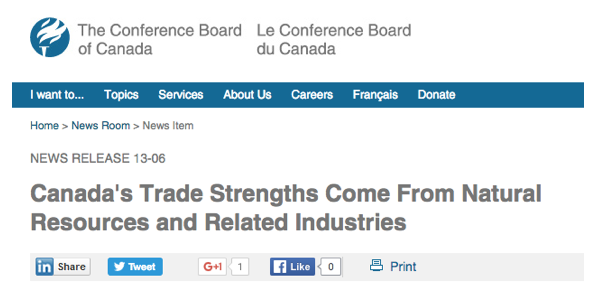Saskatchewan is rich in farmland and is known as “the breadbasket” because of such fertile soils. In fact, Saskatchewan is one of the world’s major producers of wheat. Saskatchewan also produces some beef. Alberta, while also being able to grow wheat, is known better for beef production. So both regions could produce both types of products, and sell both types of products at home. Why shouldn’t Saskatchewan and Alberta each produce both goods rather than specialize and trade?
Let’s make some simplifying assumptions. Let’s say that Saskatchewan is better at producing wheat and that Alberta is better at producing beef. What I mean by “better” is that it takes fewer resources to produce the good. Table 9-1 shows the total production of each product in each province.

Table 9-1: Potential Production of Beef and Wheat in Saskatchewan and Alberta. Permission: Courtesy of course author Hayley Hesseln, Department of Agriculture and Resource Economics, University of Saskatchewan.
Because each region demands both types of goods, we could assume that each produces half the amount it needs. That means Saskatchewan would produce 1,000 beef cattle and 15 million tonnes of wheat. Alberta would produce 2,500 beef cattle and 10 million tonnes of wheat. The total production would be 3,500 cows and 25 million tonnes of wheat produced and consumed in the province it was grown/raised. Can trade make us better off?
Given these figures, what would you advise Saskatchewan to produce? At first glance, you see that Alberta can produce more beef than Saskatchewan and that Saskatchewan can produce more wheat than Alberta. Saskatchewan producers have an absolute advantage in producing wheat because farmers can grow more wheat than Alberta farmers. Whenever one party is able to produce a good or service quicker, faster, cheaper (more efficiently), we say they have an absolute advantage. Similarly, Alberta has an absolute advantage in producing beef. Alberta cattlemen can produce more beef cattle than Saskatchewan cattle growers.
At this point, we can see that specialization and trade will lead to a greater number of both products. Total beef production moves from 3,500 cows to 5,000, and total wheat production increases from 25 million tonnes to 30 when each province specializes. Knowing about absolute advantage makes it relatively easy to see that Saskatchewan should stick to growing wheat and that Alberta should grow beef. The idea is to produce what you’re best at, and then trade products.
But what happens if genetic engineering produced cattle better suited to Saskatchewan conditions? Saskatchewan cattlemen could improve productivity threefold to produce 6,000 head in the same period. Should Saskatchewan produce both wheat and beef? Or, only beef?

Table 9-2: Improved Productivity for Alberta Wheat Growers. Permission: Courtesy of course author Hayley Hesseln, Department of Agriculture and Resource Economics, University of Saskatchewan.
Table 9-2 shows us that Saskatchewan has the absolute advantage in both beef and wheat. To answer the question above about production, we have to revisit Module 1 and look at opportunity cost, not absolute advantage. Remember that opportunity cost is the value of the most economically promising option that is foregone.
The cost to Saskatchewan of producing 1,000 head of cattle is 5 million tonnes of wheat. The cost to Alberta of producing 1,000 head of cattle is 4,000 million tonnes of wheat. Therefore, it’s cheaper for Alberta to produce cattle (they must give up fewer tons of wheat). Alberta has a comparative advantage in cattle production because the opportunity cost is lower.
The cost to Saskatchewan of producing 1 million tons of wheat is 20% of the cattle herd, whereas the cost to Alberta of producing 1 million tons of wheat is 25% of the cattle herd. Again, we see that Saskatchewan has a comparative advantage in wheat production because the opportunity cost in terms of other goods is lower (20% cost as opposed to 25%). It doesn’t matter that Saskatchewan has the absolute advantage – there are gains to be had by specializing and trading.
When we compare trade between individuals (as was the case with Adam and Oz), regions, countries, or even continents, we can think of some areas that have no absolute advantage at producing anything. However, trade is still beneficial when countries produce what they can at the lowest cost.
Knowing what you do about comparative and absolute advantage, list a product/resource for which you think Canada has a comparative advantage.
The Conference Board of Canada has a lot to say on the matter. Click the link below to read about Canada’s comparative advantages. Note in the article the link to “sustainability” as you read about in Module 2, and about the importance of value-added and focusing production on the primary goods markets.

Figure 9-2: Conference Board of Canada news release about comparative advantage. Source: https://www.newswire.ca/news-releases/canadas-trade-strengths-come-from-natural-resources-and-related-industries-510395601.html Permission: This material has been reproduced in accordance with the University of Saskatchewan interpretation of Sec.30.04 of the Copyright Act.
At this point in the class, you will notice that what you’ve learned in earlier modules remains relevant and is key to identifying incentives and policies in local and global economies.
